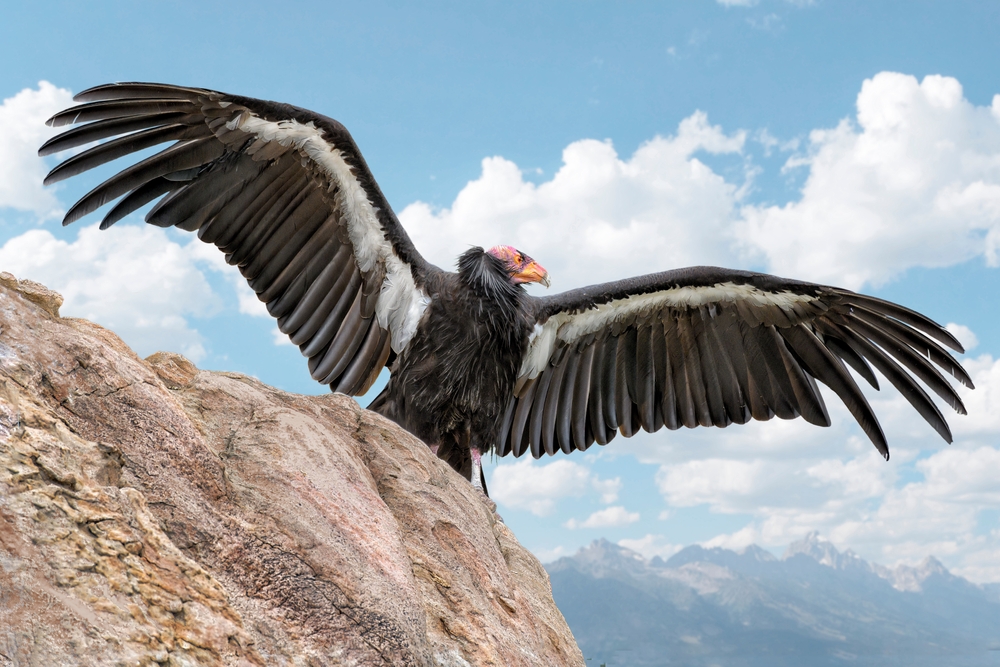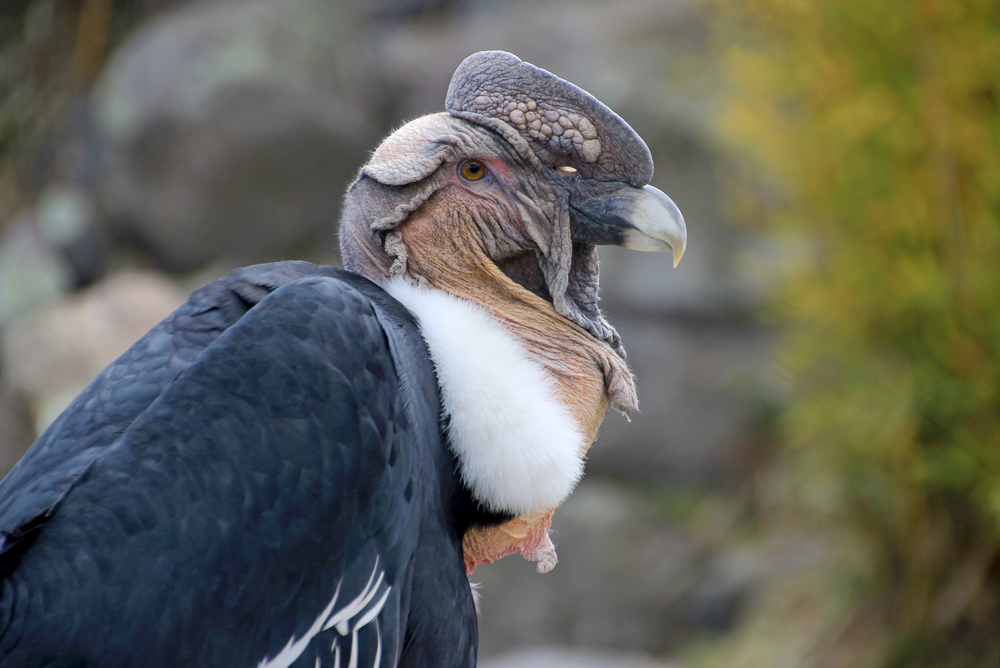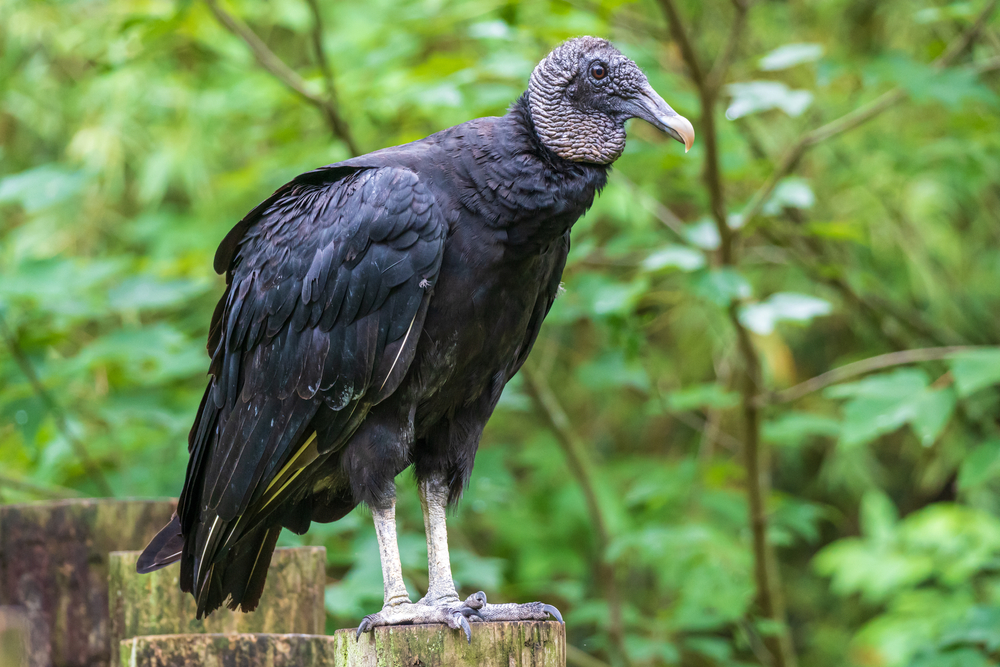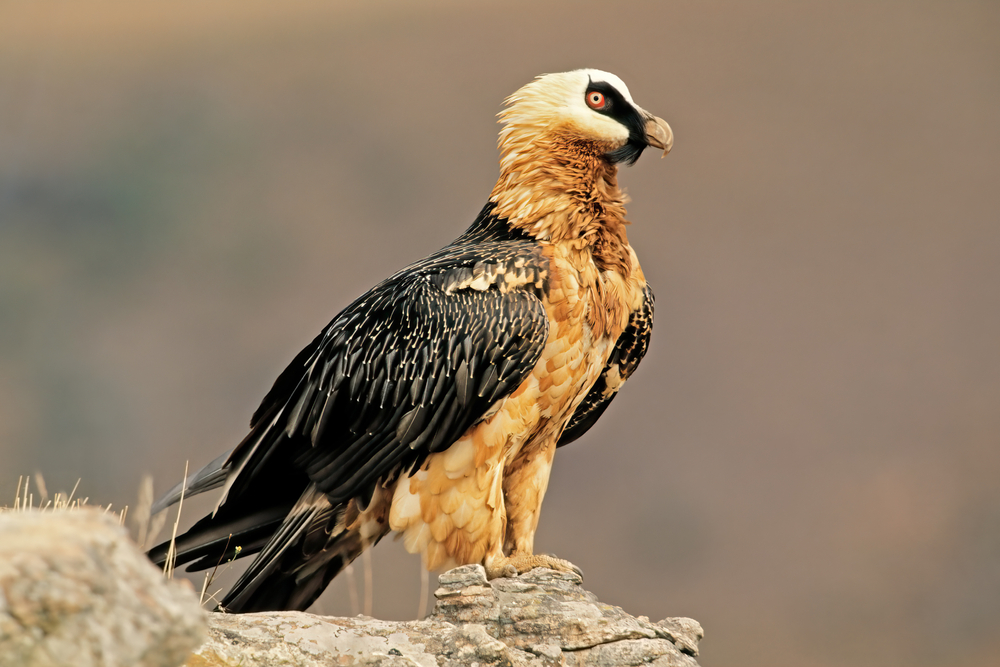The California Condor (Gymnogyps californianus) is most closely related to the Andean Condor (Vultur gryphus), its South American counterpart. Both are New World vultures, but the California Condor is slightly smaller and restricted to North America.
About
The California Condor (Gymnogyps californianus), part of the Cathartidae family, is North America’s largest flying bird and one of the most iconic conservation success stories. Once widespread across the continent, its population dwindled to just 27 individuals in the 1980s, leading to an intensive captive breeding and reintroduction program that has slowly brought the species back from the brink of extinction.
With a wingspan of 2.7–3.0 meters (9–10 ft) and weighing 8–14 kg (18–31 lbs), the California Condor is an impressive sight soaring over cliffs, canyons, and open landscapes. Adults are mostly black with striking white patches under the wings, while their bare heads range in color from yellow to orange-pink, depending on age and breeding condition. Their broad wings allow them to glide for hours, covering vast distances with little effort.
As scavengers, California Condors feed exclusively on carrion, including deer, cattle, sheep, and marine mammals. They play a vital ecological role by recycling nutrients and preventing disease spread. However, their reliance on carrion also makes them vulnerable to poisoning, particularly from ingesting lead fragments left in carcasses by hunters.
Breeding is extremely slow, with pairs producing only one egg every 1–2 years. Condors nest in caves or cliff ledges, and both parents share incubation and chick-rearing. The chick takes about 6 months to fledge and remains dependent on its parents for many more months, making recovery a long and delicate process.
Thanks to dedicated conservation programs in California, Arizona, Utah, and Baja California, populations now number in the hundreds, though the species remains critically endangered. Intensive monitoring, lead reduction campaigns, and continued captive breeding are essential for its survival. The California Condor is not only a symbol of wilderness but also of hope, resilience, and the importance of conservation action.
Physical Characteristics
The California Condor (Gymnogyps californianus) is the largest flying bird in North America, renowned for its massive wingspan and bare-skinned head.
Plumage:
-
Adults: Mostly black with striking white wing linings visible in flight. The feathers form a loose ruff around the base of the neck.
-
Juveniles: Duller overall, with mottled gray underwings instead of white. Adult plumage develops gradually over 5–6 years.
Head and Face:
The head and neck are bare, with skin color varying from yellow to orange and reddish tones, depending on age and breeding condition. The lack of feathers helps maintain hygiene while feeding on carrion.
Body and Wings:
The body is bulky with a broad chest. The wings are extremely long and broad, adapted for soaring. They use thermal updrafts to glide with minimal wingbeats, covering huge distances.
Tail:
The tail is short, wide, and fan-shaped, aiding stability and steering during gliding.
Size:
-
Length: 43–55 in (109–140 cm)
-
Wingspan: 8.2–9.8 ft (2.5–3.0 m)
-
Height at Rest: About 3.5 ft (1.1 m) when standing
Weight:
-
Adults: 17–25 lbs (7.7–11.3 kg)
The California Condor’s immense wingspan, white underwing patches, and brightly colored bare head distinguish it from other New World vultures. Its build is perfectly adapted for soaring across canyons, mountains, and coastlines in search of carrion.
Reproduction
The California Condor (Gymnogyps californianus) has one of the slowest reproductive rates of any bird, reflecting its long lifespan and extended parental care.
1. Mating and Courtship:
California Condors are monogamous, often forming lifelong pair bonds. Courtship includes wing-spreading, bowing displays, and mutual preening. Males display their brightly colored head and neck to attract females.
2. Nesting Sites:
They do not build traditional nests. Instead, eggs are laid in caves, cliff ledges, or large crevices, often in remote mountain or canyon habitats.
3. Egg Laying:
The female lays a single egg per clutch, usually every other year. Eggs are pale bluish-white and relatively large.
4. Incubation:
Incubation lasts about 53–60 days, with both parents sharing duties equally.
5. Hatching and Care of Chicks:
Chicks hatch covered in down and are completely dependent on their parents. Both parents feed the chick by regurgitation. Growth is slow compared to most birds due to their large size.
6. Fledging and Independence:
Chicks fledge at about 5–6 months old but remain dependent on their parents for up to 12 months while learning to forage and soar.
7. Breeding Frequency:
Because of their extended chick-rearing period, California Condors typically breed only once every 2 years, making their population growth extremely slow.
The California Condor’s slow reproduction, single-egg clutches, and extended parental care make conservation and captive breeding programs vital for the species’ survival.
Lifespan
The California Condor (Gymnogyps californianus) is one of the longest-lived birds in the world, with a lifespan that reflects its slow maturity and extremely low reproductive rate.
Lifespan in the Wild:
In the wild, California Condors can live 50–60 years, provided they survive the high risks of poisoning, collisions, and food scarcity. Many juveniles fail to reach adulthood, but those that do often live for decades.
Lifespan in Captivity:
In captivity, with protection from threats, reliable food, and veterinary care, California Condors may live up to 70 years or more.
Threats to the California Condor:
-
Lead Poisoning: The most significant modern threat, caused by ingestion of lead fragments from carcasses shot with lead ammunition.
-
Poisoning from Carcasses: Ingesting poisoned predator baits or environmental toxins.
-
Collisions: Strikes with power lines and wind turbines.
-
Habitat Loss: Reduction of cliff and canyon habitats used for nesting and roosting.
-
Slow Reproduction: With only one chick produced every 2 years, populations recover very slowly.
Because of these pressures, the California Condor nearly went extinct in the 20th century. Thanks to captive breeding and reintroduction programs, wild populations are recovering, but continued conservation management is critical to ensure long-term survival.
Eating Habits
The California Condor (Gymnogyps californianus) is a specialized scavenger, relying entirely on carrion as its food source.
Diet:
-
Large Mammal Carrion: Primary diet includes deer, elk, bighorn sheep, cattle, and horses.
-
Marine Carrion: In coastal areas, they feed on sea lions, whales, and fish carcasses washed ashore.
-
Other Sources: Will also consume smaller carcasses, though they prefer large animals that can support multiple birds at a feeding site.
Hunting Strategy:
-
Soaring Search: California Condors soar for hours using thermal updrafts, scanning vast areas with their excellent eyesight.
-
Communal Feeding: Often feed in groups, where a strict hierarchy determines which birds feed first.
-
No Predation: Unlike falcons or hawks, condors never kill live prey; they rely solely on scavenging.
Feeding Behavior:
-
Possess a strong, hooked beak capable of tearing through tough hides and muscle.
-
Bare head and neck prevent feather fouling while feeding deep inside carcasses.
-
Can gorge themselves on up to 3–4 lbs (1.5–1.8 kg) of food in a single sitting, then go several days without eating.
Success and Adaptability:
The California Condor’s soaring efficiency and ability to locate carrion over vast distances make it one of the most effective scavengers in North America. However, its dependence on large carcasses and vulnerability to toxins like lead fragments make it highly sensitive to environmental pressures.
Uniqueness
The California Condor (Gymnogyps californianus) is one of the rarest and most distinctive birds in the world, with several traits that set it apart from other raptors.
Largest North American Bird:
With a wingspan of nearly 10 ft (3 m), it is the largest flying bird in North America, built for soaring vast distances across canyons and coastlines.
Ancient Lineage:
Part of an ancient group of New World vultures, the California Condor once ranged across most of North America. Fossils show its ancestors lived alongside mammoths and saber-toothed cats.
Brightly Colored Head:
Adults develop a bald head with orange to reddish skin that changes shade with age, health, and breeding condition, making it a unique visual signal among vultures.
Slowest Reproduction of Any Bird of Prey:
They lay only one egg every 2 years, with chicks dependent on parents for more than a year. This makes population recovery exceptionally slow.
Near-Extinction and Recovery:
By 1987, only 27 condors remained, all taken into captivity. Thanks to intensive breeding and reintroduction, over 300 condors now fly free, though survival still requires human management.
Cultural and Conservation Symbol:
Revered by many Native American tribes as a sacred bird symbolizing renewal and power, the condor today is a global symbol of conservation success and fragility.
The California Condor’s immense size, ancient heritage, and dramatic comeback from extinction make it one of the most unique and inspiring birds on Earth.
Be the First to Share Photos of This Species.
FAQ’s
1. What is the species closest to the California Condor?
2. How does the California Condor compare to other vultures?
The California Condor is the largest flying bird in North America, with a wingspan rivaling the Andean Condor. Unlike Turkey Vultures or Black Vultures, it feeds mainly on large mammal carcasses and breeds extremely slowly, producing only one chick every two years.
3. Which national parks provide the best opportunities to see a California Condor?
Which national parks provide the best opportunities to see a California Condor?
-
Grand Canyon National Park (Arizona): One of the most reliable places to see reintroduced condors soaring over the canyon.
-
Zion National Park (Utah): A major release site with frequent sightings along cliff faces.
-
Pinnacles National Park (California): Known for nesting and roosting condors.
-
Ventana Wilderness (California): A reintroduction site near Big Sur where condors soar along the Pacific coast.






































































